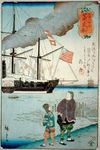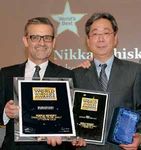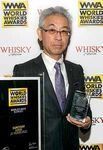Japanese Whisky Comes of Age - Scottish Field
←
→
Page content transcription
If your browser does not render page correctly, please read the page content below
PART ONE
Japanese Whisky Comes of Age
The worldwide fanfare might be recent but Japan has been making whisky for nearly a century. The
Japanese have been drinking it even longer than that. Proper whisky making began in 1924 after
the country’s first legitimate venture, the Yamazaki Distillery, was established a year earlier. The real
whisky-making process only became known after a young chemist named Masataka Taketsuru went
to Scotland in 1918 to learn first hand how it was done.
The Scots might have showed Japan the way but it was the
Americans who introduced the drink when, in July 1853,
US naval vessels showed up in Tokyo Bay to force open the
country after its more than 200-year period of self-imposed
isolation. Americans brought casks of the stuff as well as
other presents to show off Yankee know-how, such as a
miniature steam train, an early camera and the telegraph.
Over the course of the following century, Japan would
master all of these, producing world-class trains, cameras
and communication systems. Now, Japanese whisky is
considered one of the world’s original five classic whiskies,
joining the likes of Scotch, Irish, Canadian and American.
Throughout the 20th century, Japanese whisky didn’t get
the respect it deserved but now that’s changed. Between
2001 and 2017 Suntory’s and Nikka’s whiskies have each
won over a hundred accolades from the industry’s most
prestigious international competitions, while other domestic
makers such as Venture Whisky, Mars Whisky and the
Kirin Distillery have also garnered prizes and international
acclaim. Japanese whiskies are hailed as among the world’s
best. The country’s distillers and blenders have also been
awarded for their excellence.
It wasn’t only awards that Japanese whisky was accumu-
lating. After a steady decline since the 1980s, whisky sales
in Japan began increasing in 2008, due in large part to
Suntory’s highball campaign. Moreover, in 2014 Nikka
saw a 124 percent spike in sales thanks to the Japanese TV
drama Massan about the life of founder Masataka Taketsuru, Meaning? It wasn’t making as much either. Nikka was
who also first managed the Yamazaki Distillery. A combina- forced to revamp its line-up, releasing single malts without
ton of awards and international attention meant that within age statements. Likewise, Suntory’s Yamazaki malts with age
a year Nikka was no longer releasing whiskies from its statements seemed to temporarily vanish from the stores.
Yoichi and Miyagikyo distilleries with age statements. There There was no way that decades earlier the country’s whisky
simply wasn’t the stock, because 10–15 years prior Japan and makers could have known they were making the world’s
the whole world wasn’t drinking as much Japanese whisky. most desirable spirit—or even the most expensive one.
8Left Suntory released its
first Yamazaki single malt
in 1984. That same year,
Nikka released a single
malt from the Nikka
Hokkaido Distillery, now
called the Yoichi Distillery.
Above Visitors at Suntory
Yamazaki can peruse the
thousands of samples in
its whisky library.
At auctions, rare Japanese whiskies are now fetching Above Many Japanese bartenders dress in white shirts and
staggering prices. In 2015, a set of 54 bottles from the ties but not all. Here, at Fukuda Bar in Osaka’s Takatsuki,
Yutaka Fukuda is decked out in a green Guinness T-shirt.
former Hanyu Distillery went for HK$3.8 million
Besides Japanese whiskies, the bar has an eclectic selection
(US$486,588), while two years later a bidder shelled out of Scotch and bourbon.
HK$1,298,000 (US$166,207) for a 52-year-old Karuizawa.
It’s not only the defunct distilleries like Hanyu and sales increasing year by year, thanks to increased interest
Karuizawa that command jaw-dropping prices. In 2016, a from abroad and to the quality tipple distilleries make.
single bottle of 50-year-old Yamazaki went for HK$850,000 Japanese consumers, who only a few years ago might have
(US$108,842) at auction, making it also one of the most thought whisky was dated, fuddy-duddy and hardly hip,
expensive whiskies ever sold. But it’s not just the rare stuff have once again become big whisky drinkers, with single
that is pricey! Even the available Japanese single malts and malts, pricey blends and fizzy highball drinks enjoyed at
blends without age statements are sold at premium prices, restaurants, bars and homes across the country.
often commanding slightly more than their older Scottish The distilleries featured in this book produce world-
counterparts. But whisky fans all over say they’re worth it. class, highly lauded whisky. If quality is measured in praise,
The Japanese whisky business hasn’t returned to its early then whisky doesn’t get much better than what Japanese
1980s heyday but is doing better than it has in ages, with distilleries are making.
9Japanese bars are the best places to drink
Japanese whisky. Part of the fun of drinking
in Japan is walking into a random bar and
seeing what they have.
Japanese whisky as we know it would not have been
possible without Suntory and Nikka and the two men who
founded them—Shinjiro Torii and Masataka Taketsuru. But
Suntory and Nikka aren’t the only game in town. In fact,
from the mid-1950s to the early 1960s Nikka wasn’t even
the second biggest selling brand in Japan, coming in third
place behind Ocean Whisky (for more on Ocean and the
now demolished Karuizawa Distillery, see page 28). That
changed around 1965 when Nikka pulled into second place
behind Suntory. Today, Kirin, Mars Whisky, White Oak and
Venture Whisky each have their own approach and their
Japan’s Biggest and Best Whisky Makers own history. All produce award-winning, world-class stuff.
In Japanese culture, the term ryuko (龍虎) means “dragon But Japanese whisky does not stop there because there are
and tiger” and refers to two great rivals. In terms of also brand-new distilleries breaking ground and beginning
Japanese whisky, these are Suntory and Nikka. According to tell their own story. At the time of writing, new whisky
to a 2016 estimate from The Nikkei Business Daily, Suntory distilleries are beginning production. An increasing number
commands 56.3 percent of the whisky market and Nikka of Japanese drinks companies are also including whisky in
takes 27.8 percent, with the rest divvied up among other their production line-up or reviving their whisky produc-
producers. Some whisky drinkers say they prefer Suntory’s tion. Over time, expect these new and restarted distilleries
products while others say they like Nikka’s best. As whisky to make better and better stuff. Maybe one day they’ll even
lovers, we should be thankful there are both. find their spot next to the country’s best.
Right and far right Suntory
Whisky chief blender Shinji
Fukuyo accepts an accolade
for Hibiki 21 Years Old, a
whisky that has won
consecutively at the World
Whiskies Awards. Nikka
chief blender Tadashi
Sakuma accepts awards for
Taketsuru Pure Malt 17 Years
Old, which won the World’s
best blended malt and the
best Japanese blended malt.
10How Japanese Whisky is Made
A Note about Spelling
Written in English, it’s Japanese whisky,
with no “e,” reflecting its Scottish
heritage where “whisky” typically is
“e”-less on bottles and labels. In Canada, Three different spellings for “whisky” in
Ireland and the United States, the Japanese: a poster for Nikka’s first whisky
popular spelling is “whiskey,” with an “e.” released in 1940, a Torys billboard from the
1960s, and a present-day Nikka advertise-
But this distinction isn’t always iron-clad.
ment in Sapporo.
For example, Americans have used both
“whisky” and “whiskey” spellings. The
discrepancy is now a way of separating
the different traditions. However, for
Japanese whisky, the spelling isn’t only a
way to acknowledge Scotch’s influence
but is also part of the word’s linguistic
history in Japan.
In 1814, an early English–Japanese numerous ways to write whisky, such
dictionary was published in Japan. as ウイスキ (uisuki), ヰスキー (wisukii) and
Commissioned by the Dutch, who were ウヰスケ (uwisuke). When Kotobukiya
at that time the only Westerners allowed (now Suntory) launched the first true
to trade in Japan, the dictionary was Japanese whisky, Shirofuda (White Label),
somewhat useless for those hoping “whisky” was ウ井スキー (uisukii), with the
to communicate with native English kanji character 井 (i) meaning “well” as in Nikka change? The official reason is that
speakers since words were written with “water well.” In the decades after World when the company registered its corporate
Dutch pronunciations. Notably, it also War II, Suntory changed to the standard name, Nikka Whisky, in 1952, it used the
did not feature the word “whisky,” ウイスキー (uisukii). Japanese katakana character ヰ so that it
perhaps because the Dutch are tradi- During its early years, Nikka also wrote didn’t mix kanji and katakana characters
tionally gin drinkers. The first proper ウ井スキー (uisukii), mixing kanji and in the same word, which isn’t done in
English–Japanese dictionary, however, katakana. Simply put, Japan’s complex standard Japanese. The idiosyncratic
did. Released nearly 50 years later, in writing system uses kanji for ideographic ウヰスキー (uwisukii) appears on Nikka’s
1862, it was compiled by Tatsunosuke writing, hiragana characters to conjugate website and the Yoichi Distillery gate.
Hori, a translator during Commodore verbs and in lieu of kanji, and katakana However, the earlier style ウ井スキー
Perry’s visits. Between “whisker” and characters for imported foreign words, (uisukii) is still at a Yoichi photo op spot.
“whisper,” there is an entry for “whisky,” such as “whisky,” and onomatopoeia. So Also note that the standardized uisukii
written with no “e.” (At that time, when Nikka wrote whisky as ウ井スキー (ウイスキー) is in small print on all Nikka
whisky’s spelling was still fluid in the UK (uisukii), mixing the kanji character 井 (i) bottles, as on all domestic whiskies for
and the US and the word was written for “well” with phonetic katakana the clarification of consumers.
with and without the “e” in both characters, it was reinforcing Masataka While these variations in Japanese
countries.) The 1862 dictionary defines Taketsuru’s belief that good whisky needed might be the closest the country has to
whisky as “the name of a strong drink.” good water. Today, however, the official the English language whisky vs whiskey
Sounds about right. way Nikka writes whisky is ウヰスキー hullabaloo, this book follows the accepted
In Japanese, the now standard way to (uwisukii), using the obsolete Japanese regional spellings—“whisky” for Japanese,
write whisky is ウイスキー (uisukii). In the katakana character ヰ (wi), which was Scotch and Canadian, and “whiskey” for
early 20th century, however, there were originally based on the kanji 井. Why did American and Irish.
11Japan’s Whisk(e)y History Begins
On July 8, 1853, four American warships sailed into Tokyo Bay with smoke billowing out of their
coal-fired steam engines and with US guns aimed at the coast. The Japanese called them kurofune
(黒船), or “black ships,” and even today the term is used to describe something that comes from the
outside and shakes things up. While this was not America’s first contact with Japan, Commodore
Matthew C. Perry wanted to force open the country to diplomatic relations and trade. In the 1630s,
Japan kicked out the Portuguese missionaries and began an isolationist policy known as sakoku
(鎖国), or “locked country,” limiting international trade to the Dutch, Koreans and Chinese.
When warnings to turn back went unheeded, Japan didn’t who the real Emperor was or what he did, thinking he was
have much choice but to relent. In the days that followed, meeting with Imperial aids and not representatives of the
samurai boarded Commodore Perry’s steam frigate to begin Shogun, Japan’s de facto ruler. Thanks to Dutch books,
talks. The Americans, with their Manifest Destiny and reports and maps, the Japanese knew a lot more about the
gunboat diplomacy, were unwelcome guests, but aboard Americans than the Americans knew about them! The
their ships they did what any proper host would do and actual Emperor, over 200 miles away in Kyoto, would not
served them refreshments, in this case American whiskey. have wanted the gifted barrel of American whiskey (or the
From the sound of it, the distilled drink was a hit. According champagne, the telescope, the muskets, the Calvary swords,
to the official US report, at least, the samurai bureaucrats the pistols, the perfume, the books or anything else that the
“seemed to relish” the Western spirit, mixing it with sugar Yanks brought). All Emperor Komei wanted was for the
and guzzling “plentiful draughts.” Americans to leave, and he spent the rest of his life praying
Commodore Perry left Japan on July 17, 1853, but he that those barbarians would do just that. He would’ve been
returned the following February with more boats, more aghast to learn that his son, the future Emperor Meiji,
men and more booze. To show off Western superiority, known to polish off several bottles of champagne in an
Perry also brought presents for the Emperor and other evening, not only loved foreign booze but ruled during
top-level samurai. But Commodore Perry had no idea the country’s push to modernize and Westernize.
12Opposite Samurai and naval officers sharing food and drink aboard the USS Powhatan.
Above A Japanese folding screen, hence the fold down the middle, estimated to date between
1853 and 1868, showing the gifts that Perry’s expedition brought. In the middle is a cask,
presumably one filled with American whiskey. (Historiographical Institute, University of Tokyo)
While Emperor Komei was not pleased, his loyal samurai amongst other presents to the Emperor of Japan, has sent
were getting hammered. On March 27, 1854, only days him a barrel of American Whisky [sic],” adding that the
before the two countries inked their first diplomatic treaty, paper wanted to know to what effect the “republican John
the Americans held a shindig aboard the USS Powhatan for Barleycorn” had on the Emperor. Here “republican” refers
their Japanese counterparts. In his memoirs, crew member to America’s democratic government in contrast to Japan’s
J. W. Spalding gave a vivid retelling of the lavish banquet, imperial ruler. There doesn’t appear to be a surviving record
which started with a bang, literally. After a howitzer of what kind of American whiskey this was. Since the
demonstration, dinner was served, but it was the drinks, Americans brought beer as well, this could also be the “very
Spalding noted, that made the Japanese delegates much potent” John Barleycorn drink Spalding mentioned. Beer
more sociable. “With such a people, John Barleycorn is wasn’t new to the Japanese because the Dutch had previ-
very potent: particularly in treaty ously introduced it. However, one
making,” Spalding wrote. Japanese account from Perry’s
“John Barleycorn” is a per- arrival compared the gifted brew
sonification of barley and the to “horse piss.”
alcoholic drinks it makes, namely Whatever was served, American
malt beer and whisky. Because whiskey, Scotch or “horse piss,” the
the great Scottish poet and event sounded like quite the soiree.
whisky aficionado Robert Burns Commodore Perry later recalled
had published a version of the that after the banquet, as the then
ballad in 1782, this led to thoroughly sauced Japanese
Japanese whisky writer Mamoru delegates were leaving the ship,
Tsuchiya claiming that both one of them threw his arms around
American whiskey and Scotch the Commodore, saying, Nichibei
were served. Maybe, but in doushin (日米同心), which was
19th-century America “John translated for Perry as “Nippon and
Barleycorn” did not exclusively America, all the same heart.” In his
refer to Scotch whisky. There are drunken embrace, the samurai
instances of it meaning beer and crushed the Commodore’s new
even US whiskey. For example, epaulettes.
on August 30, 1854, the Washing- Smoke billows from an American kurofune
ton Telegraph wrote, “The (black ship) in this 19th-century Hiroshige
President of the United States, woodblock print.
13You can also read


























































